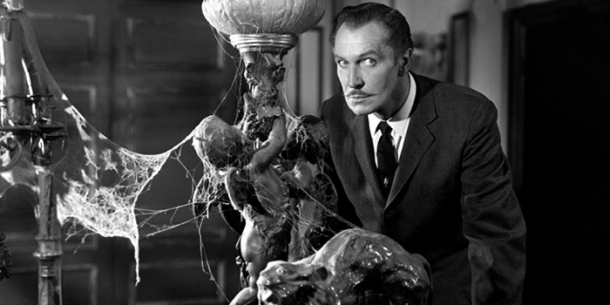
Fright Week: Informing the Present: House on Haunted Hill
Written by: Meaghan Clohessy, Special to CC2K
For CC2K’s Fright Week, here is The Moviola’s own Meaghan Clohessy on masters of horror William Castle and Vincent Price, and their spookfest House on Haunted Hill.
The success of James Wan’s The Conjuring has signaled a shift in horror. Popular horror films are departing from the gritty and postmodern, focusing instead on the stylistic direction of horror legend William Castle. Eerie music, audience participation, hilarious gimmicks? All were included in Castle’s toolbox long before Wan’s team used them for their films. Considering this connection to Castle, it is best to revisit his famous film: House on Haunted Hill. Starring Vincent Price, it is a fine example of a prolific film career as well as a good template for the current trend of popular horror films.
For those unfortunate few who never watched “Svengoolie,” Vincent Price plays Fredrick Loren, a millionaire who invites five people to spend the night in a mansion notorious for haunts. If his guests can survive the night, each person will receive ten thousand dollars. One caveat: the doors to the house are locked at midnight. Not long after this ominous message, the haunts begin.
Castle loved nothing more than to hear his audience scream. As a result, his horror films are an invitation to participate in his fright-fest. Castle first lures audiences through a seductive trailer. After asking audiences if we dare enter the infamous house, a ghostly image of Price appears. He personally invites audiences to the house by asking if they would like to be added to the list of the murdered. This inviting presence continues into the film, culminating when Price looks directly into the camera and says “I wonder how it will end.” By breaking the fourth wall, Price has implicated his audiences. He is assuring participation by making us active witnesses in the film’s crimes. Audience participation is all part of Castle’s master plan. Now that he has lured us, we are completely at his mercy.

Castle was incredibly effective in creating fear by manipulating audience imagination. He establishes this in the first shot of the film. In that shot, the screen is black, filled with screams and maniacal laughter. It continues for thirty seconds, never revealing the source. Then the head of Watson Pritchard, played by Elisha Cook Jr., comes into the view. Audiences listen to his testimony of the events that have taken place in the house. He is careful not to say the exact events. When the camera finally leads audiences inside our imagination becomes fevered. That fever runs hot when Pritchard gives Loren and his guests a tour of the house. It’s the cinematic version of sticking your hand in a bowl of spaghetti with your eyes closed and being told its brains. Audiences are shown innocuous images—a chandelier rocking, a dark liquid falling on someone’s hand—and our imagination begins to believe in the ghosts. Imagination turns into fear when the character of Norma Manning runs into a witch-like creature while exploring the basement of the house. As she screams, so does the audience in a moment of catharsis. The audience feels safe, thinking they have overcome the horror. Little do they realize that the process of manipulation has started again.
The film also offers a fascinating discussion of space. There is a point in which Loren explains how there is no way to reach the outside world once him and his guests are locked in the house. Upon hearing this, Pritchard appropriately remarks that the house is like a coffin. Obvious foreshadowing aside, enforced isolation creates a new reality within the space of the house. Overwhelming feelings of solitude leave the guests trapped by their own fears. While these fears are unfounded, as Loren points out, communication with the outside is impossible. There is no one to provide logic to the guests’ troubled imaginations. The social construct of the outside world is invalid. The house has become the reality to the guests, complete with its own set of rules and moral standards. Audiences are subject to a similar reality. They too are confined to a space: the movie theater, the living room, the dorm room. By watching the film, they entering the reality Castle has created. At the film’s conclusion, Loren remarks that it will be the authorities that judge his crimes. What Loren doesn’t understand is that what went on in the house are not for outside parties to interpret. That decision is left to the guests of the house, and by extension the audience.
Rife with monsters and gimmicks that would tops lists of B-horror movie marathons everywhere, House on Haunted Hill can’t be ignored. No doubt its legacy will inspire the next blockbuster horror film.
